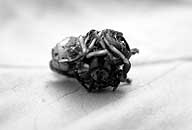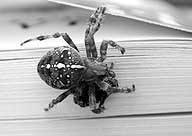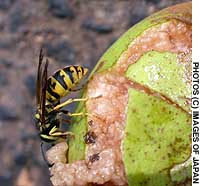Homing in on a sound of autumn
By Mark Brazil | Oct 3, 2002
WASPS' WORLDThump . . . thud . . . and thump again. It’s a perennial autumn sound — the sound of falling fruit. Overripe on the branch, sometimes already rotting, apples, pears, persimmons and plums fall and burst, splattering strong-smelling juices that don’t long go wasted.
The partly fermented fruit is irresistible to all manner of animals, but invariably among the first drawn to gorge on it are wasps — their whirring wings providing another perennial, though less welcome, autumn sound.
Nonetheless, next time a wasp is nearby you could do worse than take a close (but cautious) look — as there’s lots to know about these yellow-and-black insects notorious for their sting. Recently in this column I wrote in some detail about ants, and if you have ever looked closely at them, you may have realized that they share close affinities with wasps, not least the nipped-in waist common to both groups of insects.
All in order
In classification terms, most of the Earth’s animal species are in just two groups: the Crustacea and the Insecta. These are sub-phyla of an enormous phylum called the Arthropoda. The sub-phylum Insecta can be further subdivided into various classes, including the winged insects — known as the Pterygota.
Within the Pterygota there are a number of orders, one of which — the Hymenoptera, a name derived from the Greek hymen (membrane) and pteron (wing) — includes ants, bees, wasps and sawflies, which all have clear, membranous wings. But as ants don’t have wings, why are they classified in this order?
I well recall watching a flock of black-headed gulls behaving oddly, flapping, snapping and pecking in midair over a small coastal town in eastern England. When I watched more closely, I discovered that a swarm of insects was rising into the warm, calm air and the gulls were picking them off in flight. Those insects were ants. During the dispersal phase they have membranous wings too, wings they shed when they reach a new colony site.
Wasps live a multitude of lifestyles; a few species live in highly complex societies, but most are solitary, and many are parasitic. Hymenopterans have mouthparts adapted for chewing or biting, and some have specialized ones for sucking nectar. Various kinds of wasps are, in addition to bees, of great importance to humans because of their role as pollinators of food and forage crops. Also, many wasps prey on garden or crop pests such as caterpillars and other insect larvae, making them helpful to human growers.
We may be most familiar with the banded stingers of the group, but in fact most wasps are harmless to humans, though their behavior toward other insects may appear rather gruesome.
Many of these parasitic species have a modified ovipositor (tube for laying eggs) that enables them to deposit their eggs exactly where they choose. They build no nests, but seek out insect larvae, which may be secreted underground or hidden deep within wood. With their movable and controllable ovipositor, they drill toward a larva, pierce it and deposit a single egg. The adult wasp then flies off leaving its eggs to develop and hatch on their own inside their hosts, which they consume for nourishment from the inside.
The predatory or scavenging wasps we are mostly fearful of also have ovipositors, but theirs are modified to inject venom used for killing prey or for defense. These are the nest-builders; they commonly live in complex societies.
Wasp nests are amazingly variable, ranging in their architectural efforts from a burrow in the ground, like that of the digger wasp, to a daubed mud cavity, such as those of my favorites, the potter wasps. The nests that cause instant fear in us humans are those made by the vespoid wasps, the paper wasps, yellow jackets and hornets that scrape fibers from dry wood (often by rasping away at old wooden buildings or fence posts) and build nests of a papier-ma^chelike material — woody plant fibers mixed with their saliva.
A job for professionals
Such nests, that are typically suspended from a roof beam, branch or cave roof by a single, central “paper” stalk, may consist of a densely packed stack of exposed combs, or it may have a protective outer covering of gray paper. Such nests may house hundreds or even thousands of individuals, and if disturbed the colony may respond by sending out 100 or more defenders — each capable of delivering several stings. Don’t mess with them; if a nest is a nuisance to you, call in the professionals.
In early spring, mated females, queens, emerge from their hibernation to found new colonies. Each queen constructs her own nest, lays eggs, forages and raises her first generation of offspring. Then she is able to stop foraging, instead ruling over her worker offspring in a classic hierarchy maintained by her aggressive, dominant nature.
As the colony matures, the workers also lay eggs, but as they have not mated their eggs are unfertilized and so develop only into males. Further queens, laid later in the season, are able to mate with these males. During late summer and autumn, the males, unmated worker females and the founding queen all succumb to age or the falling temperatures, leaving only the newly mated queens to hibernate and survive the winter.
The following spring it will be their turn. The potter (or mason) wasps I mentioned earlier — those that build pot-shaped mud nests — are a group of caterpillar-hunting insects that are widespread in temperate regions of the northern hemisphere. They feed on flower nectar as adults, but also hunt small caterpillars. These they paralyze with their stinger and push into a brood cell where the female wasp will lay an egg. As each potter wasp larva requires up to 12 caterpillars to grow to full size, these wasps are important in the natural control of these wormlike larvae.
Turning the tables
In the same way, other wasps, predictably known as spider wasps, hunt spiders and feed these to their young. But in a reversal of fortunes, I recently watched a large garden spider (Aranaeus diadematus) turn the tables on a wasp.
The spider had built a large web across the front of a dense laurel hedge. Meanwhile, a wasp, which had been bothering me as I ate an apple, blundered into the web. The spider’s response was swift, as it rushed across its web and then with a swirl of silk ensnared the wasp. The spider spun the wasp between its feet, wrapping it around until it was soon cocooned in silk. Next, the spider dragged its victim from its web to a shadier spot beneath a leaf, where it pierced it and sucked it dry. The remnant of the spider’s meal was a rounded black-and-yellow bundle about half the size of the original wasp.
Just revenge don’t you think, for all the depredations of spider wasps?



